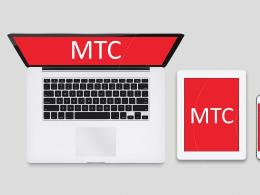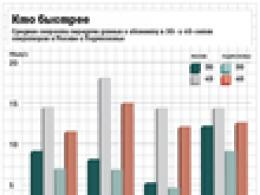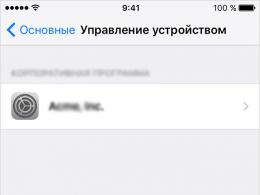Icons jump on the windows 10 desktop. How to fix blinking shortcuts on the Windows desktop
Not cool jumping icons on the desktop Windows desktop 10. Not by themselves, of course. But when you try to move the icon to the left side of the desktop, it spontaneously jumps back to its original place.
This doesn't happen all the time, but quite often. That's why it's annoying.
Since it is difficult, if not impossible, to arrange individual icons in a convenient place.
And in this post - about what to do if such a bug appeared in Windows 10 and now the icons do not move and jump.
So, we have found only two ways to eliminate this trouble so far. But both are quite effective and now we will talk about them.
method No. One - align icons
That is, just click right click mouse over any free icon on the desktop, then in the pop-up menu, select " View " and then turn on - " Align icons to grid ". The option to align the icons will automatically line them up, after which they will move without unnecessary “maneuvers”.
If the jumping bug happens again, just align the icons in this way again. The only inconvenience is that fewer of them will fit on the desktop, since the system will arrange them at large intervals. Therefore, you can also customize the placement of icons using Registry Editor .
You can do this in the following way:
- click Windows button on the keyboard, in the search bar, enter regedit.exe , press Enter and then in the results of the double click error we launch editor Windows Registry (he - Windows Registry Editor);
- confirm account(UAC) if the system issues a request;
- further into left side window " editor» click HKEY_CURRENT_USER\Control Panel\Desktop\WindowMetrics ;
- now in right side windows we find two files:
IconSpacing (determines the distance between the icons on the desktop horizontally): change the default value -1725 (right-click on the file name, in the menu click " Change" and than - " OK“) to a value in the range from -480 to -2730 (a hyphen before the number is mandatory);
IconVerticalSpacing (distance between icons vertically): the default value of -1725 is also changed in the range from -480 to -2730.
- for the changes to take effect, you must either restart the computer, or in " Task Manager» (Ctrl + Shift + Esc) end the process, and then start it again for « Explorer» (explorer.exe).
method number two - grab and drag aimingly
And this is not a joke at all. As it turned out, a bug due to which icons jump , appears or does not appear depending on where the mouse cursor is during the process of moving the icon. And if you move the icon by “grabbing” it with the mouse cursor on the left side, then in most cases it moves normally and does not jump anywhere.
How to fix the problem when shortcuts on the Windows desktop are flashing? Users often encounter such a system error. Although the error may not lie in the OS. Icons can blink for a variety of reasons.
Causes
Such strange behavior of the elements of the main screen indicates serious errors in the operation of the PC or in the operation external devices. Often shortcuts flash on the desktop shortly after upgrading from 7 to Windows 10.
First you need to press "Ctrl + Shift + Esc" and open the "Task Manager". Next, you need to pay attention to the elements available there, located in the window that opens. If they flash, like the shortcuts, then the problem lies in the operation of the video card or in the driver packages for it.
If the flickering has stopped or continues only on the desktop, the problem is in the service or incompatible program.
Reinstalling drivers
Drivers for the video card, and for all other computer components, should be kept up to date. But for updating (including for solving an error), options using a specialized software. In this case, it is better to pay attention to manual search and installation by visiting the official website of the video card manufacturer. It will also not be superfluous to check the version installed driver, to do this, open the "Device Manager", find the "Display adapters" section, open the "Properties" of your component and pay attention to the version of the driver used on the tab of the same name.

Disabling services
On Windows 10, disabling some special system services helps. Because of them, such problems often occur.
- Open Task Manager.
- Select the "Services" section. To do this, you need to open the advanced mode of the manager.
- We are looking for two lines: "Registration Service Windows errors and Problem Reports and Solutions. (Problem Reports and Solution Control Panel Support and Windows Error report service).
- We turn them off.
After that, as a rule, all shortcuts on the desktop stop blinking. This method has only been tested on Windows 10.
Other causes and solutions
One of the problems that causes flashing may be a malfunction of the keyboard or individual keys. Check if the F5 key is stuck. On most PCs, it is responsible for fast updates. Thus, the icons can simply be updated indefinitely when this button is clicked. You have a stationary computer - try to put a different keyboard. If the problem persists, then it's not the problem.

Problems may be related to the operation of the video card. Rather, with the settings of its work. This method helped people who had NVIDIA graphics card, but may work with other video cards.
- Open the NVIDIA Control Panel (or AMD if you have one).
- In the top menu, click on the "Desktop" button.
- Uncheck "Add context menu".
- Restart your computer.
A disabled option causes the screen to constantly update, which manifests itself in the form of endless blinking.
It's a good idea to check the Windows Journal logs for software that often causes errors. Perhaps it is in this software that the essence of the problem lies.
For this:
- Press "WIN + R" and execute the command "compmgmt.msc";
- Open the "Event Viewer" - " Windows logs»;
- Pay attention to the logs of the "Applications" and "System" sections.

Identify the possible culprit and remove it in any way possible.
Now you know how you can get rid of such a problem as shortcuts on the home screen constantly flashing. The methods are not suitable for everyone, but do not rush to carry the computer to the service or demolish the system without trying them.
Switching to a new OS from Microsoft is always pleasant and exciting. Except beautiful user interface people expect maximum performance and stable operation. It is a pity that some problems begin immediately or a few months after the transition to a new operating system from Microsoft. We will solve one of the most unpleasant ones today. Let's find out what to do if desktop icons are flashing in Windows 10.
Description of the problem
Blinking (flickering) of elements on the desktop is due to three reasons:
- damage to the graphics adapter driver;
- incompatibility of some programs;
- incorrect operation of one of the standard Windows services.
Each of these problems is easily solved, so let's start treating the computer.
How to fix?
First you need to find out what the problem is.
To do this, press Ctrl+Shift+Esc and open Task Manager. Look at the elements located in the window. If they are blinking, like the shortcuts, you have a problem with the video card or its driver package. If the flickering has stopped or continues only on the desktop, the problem is in the service or incompatible program. Depending on the symptoms found, go to the required item.
Driver reinstallation
Outdated or corrupted drivers affect display quality GUI user. To eliminate flicker, do the following:

Removing incompatible components
If the driver is not involved in flickering, then you need to look for a defective software component. For a successful search, do the following:
- Press Win+R.
- Enter compmgmt.msc in the text field and confirm your entry with the Enter key.

- In the window that appears, go to "Event Viewer" - "Windows Logs" - "Applications" and "System".
- Examine the information provided in the logs and identify the application that provokes a large number of errors.

- Open "This PC" - "Uninstall or change a program".

- Find desired program and uninstall it.
- Restart your computer.
This method should solve the problem with the flashing desktop. However, there is another method designed for particularly difficult cases. For this.
IN latest versions Windows 10, including the Fall Creators Update (Redstone 3), there is a bug that affects the location of icons (shortcuts) on the desktop. Who faced - knows that attempts to move desired icon to the left side of the screen usually end in failure - at the moment of "landing" it instantly returns to its original place. The topic of the "anomalous zone" has been raised many times on computer forums, read below for tips on solving the problem from popular experts IT-portals Deskmodder And gHacks.
![]()
First, I will give a simple life hack from the team Deskmodder.de. They noticed that when dragging the shortcut, luck was much more likely to favor those who placed the mouse pointer on the left side of the shortcut.
One of the authors of the articles and the founder of the visited site gHacks.net Martin Brinkmann ( Martin Brinkmann) gave a detailed solution to the problem of "jumping icons" in Windows 10. Nothing complicated: you need to enable the "Align to Grid" function, known since Windows XP. To do this, right-click on an empty space on the table and select " View"("View") → further, voiced by " Align icons to grid"("Align icons to grid").
![]()
After fixing the elements of the rabstol, another "trouble" may appear - a large distance between them.
This can not be solved through the settings operating system due to the lack of an option, but the interval is easily adjusted through system registry. To change the spacing between desktop icons (shortcuts):
- press the logo key Windows() → in the search field enter regedit.exe → "Enter";
- open the branch in the registry editor HKEY_CURRENT_USER\Control Panel\Desktop\WindowMetrics ;
![]()
- in section WindowMetrics parameter IconSpacing defines the horizontal spacing between icons (default value is "-1725", in Windows 8.1 / 7 the default value was "-1125", i.e. labels were closer horizontally), set its value between "-480" and "-2730";
- parameter IconVerticalSpacing defines the vertical spacing between icons (default is "-1725"), has the same minimum and maximum values as IconSpacing.
After setting the optimal distance between the elements of the desktop, restart the computer or force close and restart Explorer. I wrote about how to implement this in practice in " How to restore the location of shortcuts on the Windows 10 / 8 / 7 desktop": via key combination " Win +R"Open the Run window and type cmd → "OK" → in the console type taskkill /IMexplorer.exe /F → "Enter" (to launch Explorer, run the command in the console explorer →"Enter"). The final!
Dmitry dmitry_spb Evdokimov






